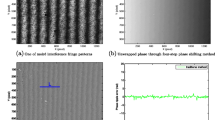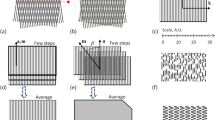Abstract
Applicability of time average geometric moiré for elastic oscillating structures is analysed in this paper. Mathematical and numerical models describing the formation of time averaged fringes are carefully constructed without the assumption that dynamic deflections are described by a slowly varying function. Though time average geometric moiré is considered as a classical optical experimental technique, we show that well known relationship between the fringe order, amplitude of oscillation and pitch of the grating in state of equilibrium can be used only when the amplitude is small. Otherwise the inverse problem of fringe interpretation becomes much more complicated and is the object of analysis in this paper. We describe the interpretation of fringes produced by time average geometric moiré in detail and illustrate the complexity of the problem by numerical examples.









Similar content being viewed by others
References
Shang H, Xie H, Wang X, Jiang S, Dai F, Wang W et al (2005) Thermal properties measurement of micro-electromechanical system sensors by digital moiré method. Strain 41:157–162. doi:10.1111/j.1475-1305.2005.00226.x.
Han A (1998) Recent advancements of moiré and microscopic moiré interferometry for thermal deformation analyses of microelectronics devices. Exp Mech 38:278–288.
Sciammarella CA, Sciammarella FM, Kim T (2003) Strain measurements in the nanometer range in a particulate composite using computer-aided moiré. Exp Mech 43:341–347. doi:10.1007/BF02410533.
Kobayashi AS (1993) Handbook on experimental mechanics, 2nd edn. SEM, Bethel.
Patorski K, Kujawinska M (1993) Handbook of the moiré fringe technique. Elsevier, Oxford.
Field JE, Walley SM, Proud WG, Goldrein HT, Siviour CR (2004) Review of experimental techniques for high rate deformation and shock studies. Int J Impact Eng 30:725–775. doi:10.1016/j.ijimpeng.2004.03.005.
Post D, Han B, Ifju P (1997) High sensitivity moiré: experimental analysis for mechanics and materials. Springer, Berlin.
Dai FL, Wang ZY (1999) Geometric micron moiré. Opt Lasers Eng 31:191–198. doi:10.1016/S0143-8166(99)00020-2.
Liang CY, Hung YY, Durelli AJ, Hovanesian JD (1979) Time-averaged moiré method for in-plane vibration analysis. J Sound Vib 62:267–275. doi:10.1016/0022-460X(79)90026-9.
Lin CJ, Chiang FP (1982) Time-average in-plane moiré method for the analysis of nonsinusoidal cyclic loading. Exp Mech 22:64–68. doi:10.1007/BF02326078.
Mitchell AK (2005) Optical modal analysis using white-light projected fringes. Exp Mech 45:250–258. doi:10.1007/BF02427949.
Asundi A (1994) Novel techniques in reflection moiré. Exp Mech 34:230–242. doi:10.1007/BF02319760.
Ragulskis M, Maskeliunas R, Ragulskis L, Turla V (2005) Investigation of dynamic displacements of lithographic rubber roller by time average geometric moiré. Opt Lasers Eng 43:951–962. doi:10.1016/j.optlaseng.2004.10.004.
Sciammarella CA (2003) Overview of optical techniques that measure displacements: Murray lecture. Exp Mech 43:1–19. doi:10.1007/BF02410478.
Munoz-Rodriguez JA, Rodriguez-Vera R (2004) Image encryption based on moiré pattern performed by computational algorithms. Opt Commun 236:295–301. doi:10.1016/j.optcom.2004.03.089.
Sciammarella CA (1965) Basic optical law in the interpretation of moiré patterns applied to the analysis of strains—part 1. Exp Mech 5:154–160. doi:10.1007/BF02324049.
Voloshin AS, Burger CP, Rowlands RE, Richard TG (1986) Fractional moiré strain analysis using digital imaging techniques. Exp Mech 26:254–258. doi:10.1007/BF02320050.
Ning PT, Peng WL (1988) Automatic analysis of moiré fringe patterns by using an image-processing system. Exp Mech 28:350–354. doi:10.1007/BF02325175.
Riordan J (1968) Combinatorial identities. Wiley, New York.
Watson GN (1995) A treatise on the theory of Bessel functions. Cambridge University Press, Cambridge.
Ragulskis M, Saunoriene L (2006) Applicability of optical geometric differentiation for time average geometric moiré. Strain 42:173–179. doi:10.1111/j.1475-1305.2006.00273.x.
Vest CM (1979) Holographic interferometry. Wiley, Ontario.
Author information
Authors and Affiliations
Corresponding author
Rights and permissions
About this article
Cite this article
Ragulskis, M., Navickas, Z. Time Average Geometric Moiré—Back to the Basics. Exp Mech 49, 439–450 (2009). https://doi.org/10.1007/s11340-008-9167-8
Received:
Accepted:
Published:
Issue Date:
DOI: https://doi.org/10.1007/s11340-008-9167-8




